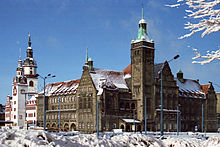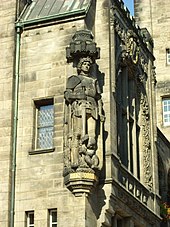New Town Hall (Chemnitz)
The New Town Hall in Chemnitz was built between 1907 and 1911 according to plans by the city building officer Richard Möbius . Together with the old town hall , the monumental building forms a striking building complex, which is also known as the Chemnitz double town hall .
history
The New Town Hall is the third town hall in Chemnitz. It became necessary because the rapid industrial development of the city and the associated rapid population growth increased the urban administrative apparatus. While the population was 100,000 in 1883, it rose to 200,000 in 1901 and to over 300,000 in 1912. The premises of the town hall on Beckerplatz , which functions as the town hall, turned out to be too small, so construction began in 1907. At that time, Chemnitz was considered the most important industrial city and second trading metropolis in Saxony .
From 1907 to 1911 the center of the city was a major construction site. Numerous old town houses had to give way to the new building, including an old Latin school from the end of the 14th century, of which only the portal remained. The new town hall, which was inaugurated on September 2, 1911 in the presence of the Saxon king , blends in harmoniously with the old town hall , without foregoing elements of Art Nouveau . Inside, Richard Möbius kept the town hall in pure Art Nouveau style. The wall painting "Work = Prosperity = Beauty" by Max Klinger from 1918 is well worth seeing .
On the facade there is a 4.75 m high Roland figure created by the Dresden sculptor Alexander Höfer . Since there was no space available on the market square itself, it was designed as a corner figure with a view of the market and the former Neumarkt. The Roland is a symbol of the contender for urban freedom and justice. Even today, this handsome town hall building, together with its furnishings and artistic design, testifies to the former importance and wealth of this city.
In March 1945 90% of Chemnitz city center was destroyed. Only the old town hall was rebuilt on the market and in 1953/1954 the Siegert house on the west side, as only an undamaged facade of the patrician houses remained. The new town hall was the only building in the city center to survive the air raids almost unscathed. Spared from direct hits, air protection members, fire brigade and other helpers in particular prevented the conflagration from spreading to the new town hall. In view of the almost complete destruction of the directly adjoining old town hall, a remarkable achievement. This makes the building of outstanding urban historical importance.
After 1990, the wall and ceiling paintings were recreated based on the historical model, and the entire stalls and lighting were reproduced true to the original. In 2005, the second floor received original windows from the glass artist Josef Goller , who played a decisive role in the design of the New Town Hall from 1910 to 1911.
The foyer
The foyer was filigree painted from 1910 by the Dresden painter Paul Perks (* 1879), it forms the central corridor of the building and provides access to the city council hall, the council hall and the green salon. Worth mentioning is the Lord Mayors' Gallery, which adorns the back wall of the hall. Six mayors and lord mayors were given the honor of being painted in oil because of their contribution to the development of the city of Chemnitz. The paintings were created during her lifetime and are therefore partly older than the New Town Hall itself.
The Green Salon
The salon got its name from the greenish stain on the wood paneling, which can still be seen on the door frames, for example. But this glaze was only applied in the 1960s, so that the room has only had its current name since that time and not from the beginning.
It is located between the city council hall and the council hall on the second floor of the town hall. Connected by a door to the city council hall, the salon once served as a refreshment room for the city councilors who spent their breaks here. After 1945 the salon, for lack of a ballroom, served u. a. as a reception room for the festive greeting of guests and was used for the occasional performance of classical concerts. Nowadays it is also used for city hall receptions and award events of all kinds and often forms the outer framework when deserving citizens are allowed to enter their names in the city's “ Golden Book ”.
Carillon
A carillon has been in the new town hall tower since 1978, the 25th anniversary of Karl-Marx-Stadt . The gaming table of the carillon is in a small chamber at the height of the tower clock, almost 60 m high. The 48 bells of the carillon hang one floor higher and are connected to the gaming table by wires. The smallest of the 48 bells weighs 9.5 kg, the largest of 957 kg and a diameter of 1120 mm. Together, the bells weigh approx. 5200 kg and have a range of 4 octaves.
The carillon was planned and designed by Apolda's last master bell founder, Franz Peter Schilling , and his wife Margarete Schilling ; The carillon bells were manufactured from 1968 to 1977 by the Schilling foundry in Apolda . The heaviest bells therefore have a hammer, circle and wreath as a signet.
Originally the tower carillon, which had been set at 85,000 marks, was to be built into the tower of the old town hall. However, because of the weight of the game, this was not possible. In 1964 the Red Tower was up for discussion for a short time, but ultimately the tower of the New Town Hall convinced the councilors of the Carillon, which now cost 140,000 marks.
The game is played all year round on Wednesdays and Saturdays from 10 a.m. to 10.30 a.m., during Advent on Wednesday, Thursday, Friday and Saturday from 9.45 a.m. to 10 a.m.
Views
Individual evidence
- ↑ Archived copy ( Memento of the original dated December 8, 2012 in the Internet Archive ) Info: The archive link was inserted automatically and has not yet been checked. Please check the original and archive link according to the instructions and then remove this notice.
- ↑ Official Journal of the City of Chemnitz, 21st edition, May 25, 2005 ( page no longer available , search in web archives ) Info: The link was automatically marked as defective. Please check the link according to the instructions and then remove this notice. (pdf)
- ↑ City leaders immortalized in portraits. ( Page no longer available , search in web archives ) Info: The link was automatically marked as defective. Please check the link according to the instructions and then remove this notice. In: Freie Presse from August 22, 2011
- ↑ Color gives hall its name. ( Page no longer available , search in web archives ) Info: The link was automatically marked as defective. Please check the link according to the instructions and then remove this notice. In: Freie Presse from August 9, 2011
- ↑ The secret of the town hall tower. In: Freie Presse from January 31, 2012
Web links
literature
- Margarete Schilling : The Carillon Karl-Marx-Stadt. Karl-Marx-Stadt 1978
Coordinates: 50 ° 49 ′ 59 " N , 12 ° 55 ′ 11.3" E







